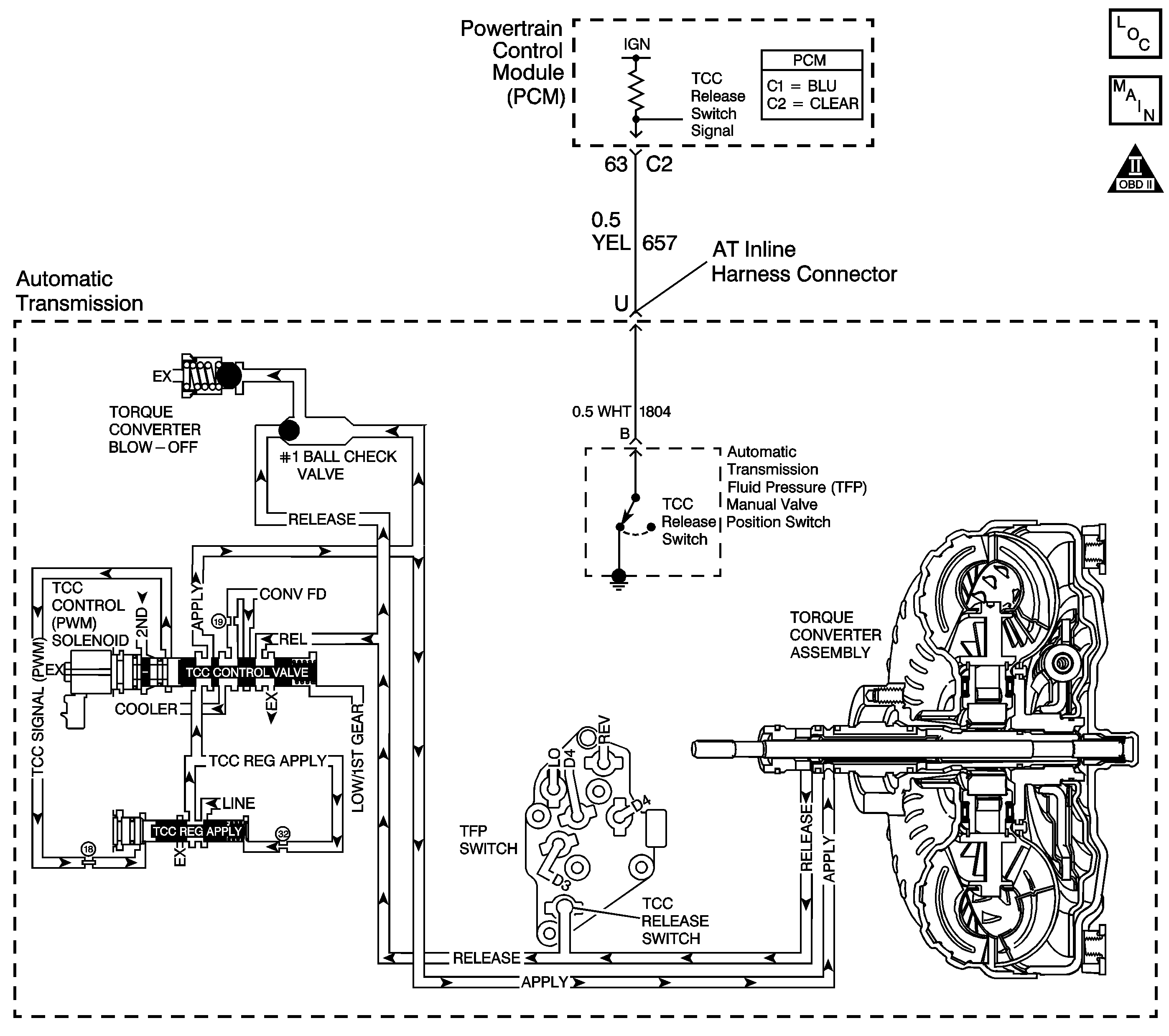
Circuit Description
The TCC release switch is part of the automatic transmission fluid pressure (TFP) manual valve position switch. The TFP manual valve position switch is mounted to the transmission valve body.
The TCC release switch is a normally-closed switch. When the TCC is released, TCC release fluid pressure opens the TCC release switch which opens the TCC release pressure circuit. When the voltage on the circuit is high (switch open), the PCM recognizes that the TCC is no longer engaged.
If the PCM detects that the TCC release switch is closed when the TCC is commanded OFF, then DTC P0742 sets. DTC P0742 is a type A DTC.
Conditions for Running the DTC
| • | No TP sensor DTC P0121, P0122 or P0123. |
| • | No TCC PWM solenoid valve DTC P1860. |
| • | No TCC release switch DTC P1887. |
| • | The engine speed is greater than 500 RPM and not in fuel shut off. |
| • | Engine torque is 95-270 N·m (70-200 lb ft). |
| • | The TP angle is 5-45%. |
| • | The transmission fluid temperature is 20-130°C (68-266°F). |
| • | The time since the last gear range change is greater than 6 seconds. |
| • | The speed ratio is less than 7.0. |
| • | The TCC is commanded OFF. |
| • | Slip speed is -20 to +25 RPM for 8 seconds. |
Conditions for Setting the DTC
The TCC release switch is closed 6 times for 4 seconds each, during one trip.
Action Taken When the DTC Sets
| • | The PCM illuminates the malfunction indicator lamp (MIL). |
| • | The PCM commands the TCC ON at maximum capacity. |
| • | The PCM freezes shift adapts. |
| • | The PCM records the operating conditions when the Conditions for Setting the DTC are met. The PCM stores this information as Freeze Frame and Failure Records. |
| • | The PCM stores DTC P0742 in PCM history. |
Conditions for Clearing the MIL/DTC
| • | The PCM turns OFF the MIL during the third consecutive trip in which the diagnostic test runs and passes. |
| • | A scan tool can clear the MIL/DTC. |
| • | The PCM clears the DTC from PCM history if the vehicle completes 40 warm-up cycles without an emission-related diagnostic fault occurring. |
| • | The PCM cancels the DTC default actions when the ignition switch is OFF long enough in order to power down the PCM. |
Diagnostic Aids
| • | The customer may notice an engine stalling condition. |
| • | If the Scan Tool indicated TCC release pressure was present in Step 2 and a mechanical or hydraulic condition was not found in Step 7, an intermittent short to ground condition may exist in the TCC release switch signal circuit. Refer to Intermittent Conditions in Engine Controls. |
Test Description
The numbers below refer to the step numbers on the diagnostic table.
-
A Yes answer indicates that the TCC is functioning properly.
-
With the 20-way connector disconnected, the PCM should interpret the open circuit as TCC release pressure present. This indicates that the wiring from the PCM to the inline 20-way connector is OK.
-
An open condition in the TCC release circuit or switch would set DTC P1887. Open circuits are not diagnosed in DTC P0742.
-
This step tests for a mechanical or hydraulic condition that would cause the TCC to be stuck ON.
Step | Action | Value(s) | Yes | No | ||||||||||||||
|---|---|---|---|---|---|---|---|---|---|---|---|---|---|---|---|---|---|---|
1 | Did you perform the Powertrain Diagnostic System Check? | -- | Go to Diagnostic System Check - Engine Controls in Engine Controls | |||||||||||||||
Important: Before clearing the DTCs, use the Scan Tool in order to record the Freeze Frame and Failure Records for reference. The Clear Info function will erase the data. Does the Scan Tool indicate Yes for TCC Release Pressure? | -- | |||||||||||||||||
Does the Scan Tool indicate Yes for TCC Release Pressure? | -- | |||||||||||||||||
Test the signal circuit (CKT 1804) of the TCC release switch for a short to ground between the AT inline 20-way connector and the TFP manual valve position switch. Refer to Circuit Testing in Wiring Systems. Did you find the condition? | -- | |||||||||||||||||
5 | Test the signal circuit (CKT 657) of the TCC release switch for a short to ground between the PCM connector C2 and the AT inline 20-way connector. Refer to Circuit Testing and Wiring Repairs in Wiring Systems. Did you find and correct the condition? | -- | ||||||||||||||||
6 |
Did you find a condition? | -- | ||||||||||||||||
Refer to Transmission Overhaul in the 4T65-E Section of the Transmission Unit Repair Manual.
Did you find and correct a condition? | -- | Go to Diagnostic Aids | ||||||||||||||||
8 | Replace the TFP manual valve position switch. Refer to Transmission Fluid Pressure Manual Valve Position Switch Replacement . Did you complete the replacement? | -- | -- | |||||||||||||||
9 | Replace the transmission wiring harness assembly. Refer to Wiring Harness Replacement . Did you complete the replacement? | -- | -- | |||||||||||||||
10 | Replace the PCM. Refer to Powertrain Control Module Replacement in Engine Controls. Did you complete the replacement? | -- | -- | |||||||||||||||
11 | In order to verify your repair, perform the following procedure:
Has the test run and passed? | -- | System OK |
